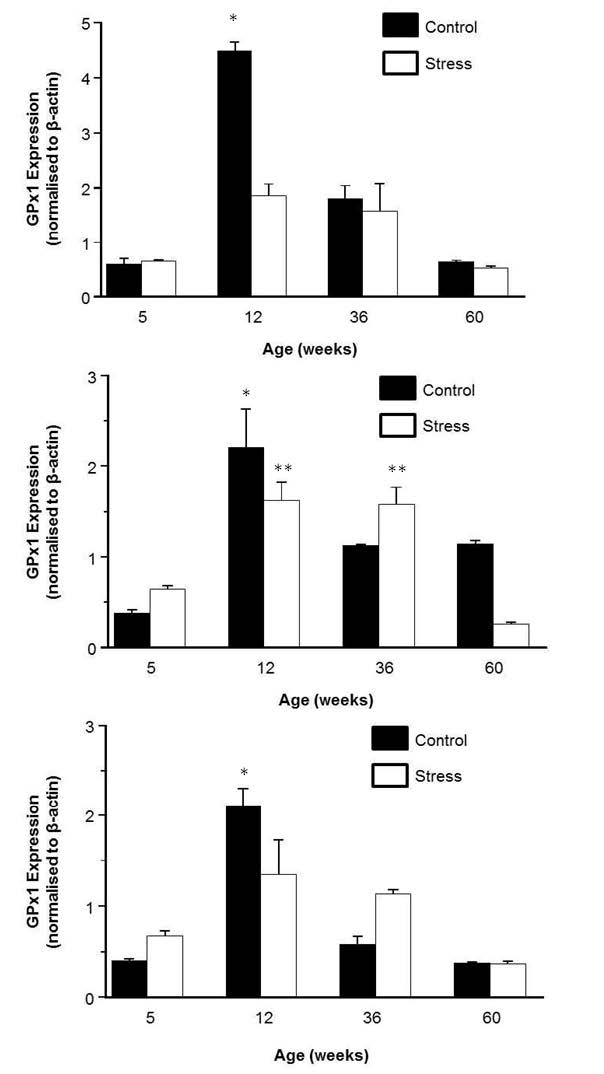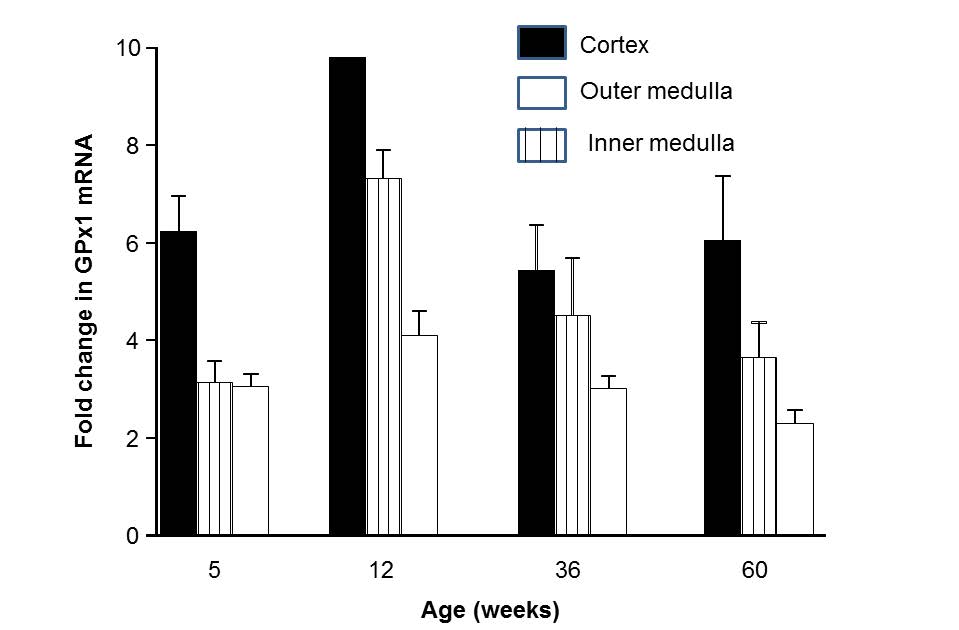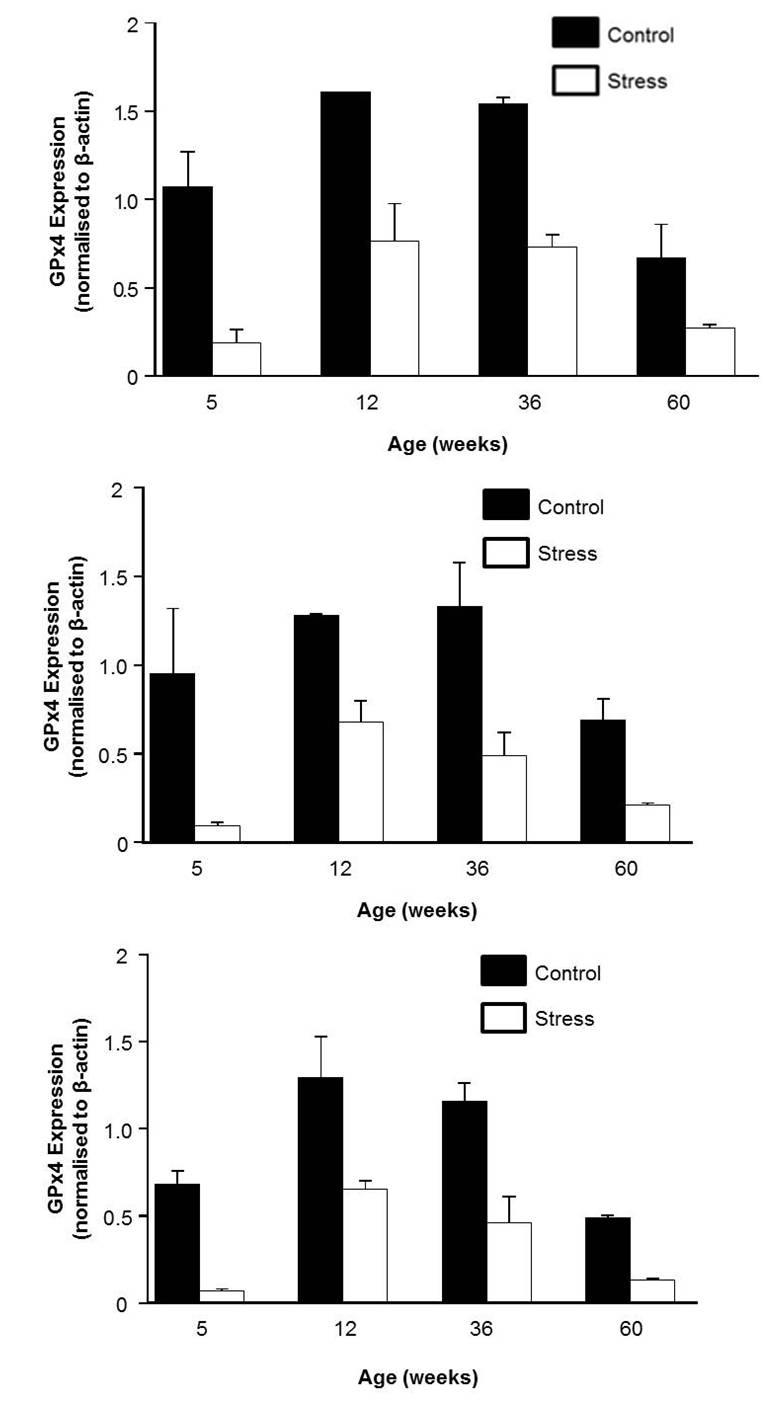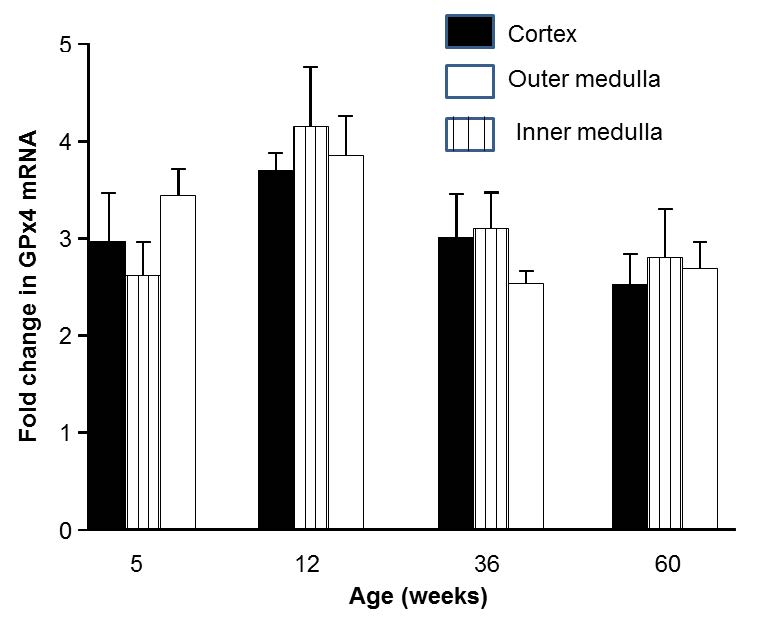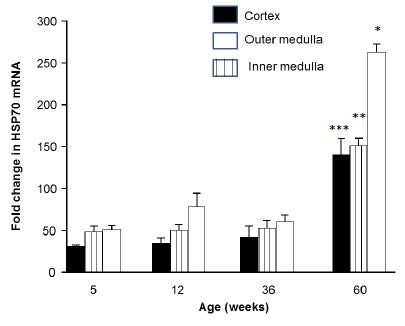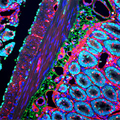1. Introduction
Ageing is a complex process that is characterised by a general decline in physiological function, leading to increasing morbidity and eventual mortality [1,2]. There is increasing evidence for an age-related decline in renal function, both in animal models and in humans [3,4,5,6,7,8,9]. Several studies have demonstrated that this deterioration is manifested in both structural (tubular atrophy, glomerulosclerosis and interstitial fibrosis) and functional (reduced drug excretion, proteinuria, reduced ability to concentrate or dilute urine, impairment of electrolyte and ion transport, decreases in glomerular filtration rate (GFR), alteration in hormonal functions) changes in the kidney. The molecular and cellular mechanisms underlying these changes are currently under active investigation [2,10,11,12]. There is some suggestion that the damage caused by endogenously produced oxidants may contribute to the age-related changes [13,14,15,16]. Such oxidants including superoxide, hydrogen peroxide, hydroxyl radicals, and possibly singlet oxygen can induce damage to cellular macromolecules, including proteins, lipids and DNA [14,15,17,18,19]. The antioxidant enzymes scavenging active oxygen species have been suggested as key factors in determining the longevity of animals [19,20,21]. Indeed, there are correlations between levels of these enzymes and the maximum life span potential of different species [22,23]. Glutathione peroxidase is a major hydrogen peroxide scavenger enzyme, found in both the cytosol and mitochondria. The enzyme and its substrate GSH, form a formidable defence against hydrogen peroxides and lipid peroxides [24,25], although the role of other anti-oxidant enzymes such as catalase should not be overlooked [26].
The so-called heat shock (HS) response is one of the primordial intracellular defence mechanisms against stress. Exposure of cells and organisms to stresses such as high temperature, caloric restriction, exercise, oxidative and osmotic stress, heavy metals, proteasome inhibitors, amino acid analogues, ethanol, glutathione depletion, calcium ionophores and metabolic poisons are among many factors that induce the cellular stress response, leading to the preferential transcription and translation of heat shock proteins (Hsps) [27,28,29]. Optimal HS response in terms of Hsp synthesis and activity is essential for cell survival. By contrast, an inefficient and altered HS response has been implicated in abnormal growth and development [30], accelerated ageing and apoptosis [31,32] and in the initiation and promotion of cancers [33,34]. Seen in this context, an elevated Hsp response provides a homeostatic mechanism to counter accumulated metabolic and environmental insults [35]. The age related attenuation of the expression of key anti-oxidant enzymes could thus be seen as amplifying such insults and therefore leading to a concomitant age related sustained increase in the expression of Hsp-70. This reciprocal relationship has been previously observed in the ageing rat brain [36]. The physiological cellular redox state is a balance between the levels of oxidising and reducing equivalents, such as reactive oxygen species (ROS) and endogenous antioxidants. It appears that during the ageing process an imbalance between oxidants and antioxidants may occur, leading to oxidative stress [24,37]. The free radical theory of ageing proposes that ageing itself and some age-related diseases are, at least in part, a consequence of oxidative stress [37,38,39].
It is hypothesised here that expression of antioxidant enzymes in the kidney may decrease either with age or under conditions of oxidative stress as oxidant homeostasis is compromised. The aim of this study was to investigate the effect of ageing on the expression of the major antioxidant enzyme GPx (1 and 4) in different regions of the kidney under control and oxidative stress conditions and to correlate such age related changes with the expression of Hsp-70 mRNA.
2. Methods
2.1. Sample collection
All experiments were approved and carried out under conditions complying with the Animal Ethics Committee of the University of New England (AEC09/152, EC10/036 and AEC11/100).
Male Wistar rats in varying age cohorts (5 weeks; 12 weeks; 36 weeks; and 60 weeks of age) were used. For each experiment, five animals from each age cohort were stunned and sacrificed by cervical dislocation. For protein assays kidneys were removed, snap frozen in liquid nitrogen and stored at −80 ℃ until use. For mRNA extraction 30 mg sections from the cortex, inner and outer medulla were dissected and placed into RNA later stabilisation solution (Qiagen, Hilden, Germany catalogue no. 76104) and stored at 4 ℃.
2.2. Tissue preparation
For SDS/PAGE and subsequent Western blotting analysis, tissue samples from the cortex, outer medulla, and inner medulla were dissected from frozen kidneys that were first thawed in ice cold phosphate buffered saline (PBS). Fifty mg of each tissue was incubated at room temperature 25 ℃ for 30 minwith PBS at a ratio of 1:1000 prior to homogenisation for 2 min (control condition). To model oxidative stress, parallel 50 mg tissue samples were placed in a0.2 mM H2O2 solution for 30min at room temperature (stress condition) prior to homogenisation. The resultant homogenates were centrifuged at 4000 rpm for 10 min at 4 ℃, and the supernatant was flash frozen and stored until later use. A thiobarbituric reactive substances assay was carried out to confirm the oxidative stress state of the tissue and this data is included in a separate publication [26].
2.3. Protein assay and Western Blots
A Bradford reagent assay was used to determine the total protein concentration in the tissue homogenates from the control or stressed condition, as per the manufacturer’s instructions.
Protein samples (50 mg) were prepared in reducing/denaturing gel loading buffer containing 250mM Tris-HCl, pH 6.8, 8%SDS, 8% beta-mercaptoethanol, and 0.02% bromophenol blue and heated at 100 ℃ for 10 minutes. Samples were separated on 10% SDS PAGE gels that included molecular weight marker proteins (Precision Plus Protein TM Kaleidoscope TM Standards No.161-0375, Bio-Rad). The separated proteins were electro-blotted onto nitrocellulose membrane (Life Science, Whatman, catalogue number 10402594). Membranes were blocked in 5% non-fat milk powder dissolved in TRIS buffered saline containing Triton (TBST) for one hour. Membranes were incubated with the following primary antibodies: mouse anti-GPx1 (1:6000; Abnova); goat anti-GPx4 (1:5000; Abnova); or mouse anti-β-actin (1:5000; Sigma-Aldrich), in blocking solution at room temperature for 2 hours with shaking followed by the appropriate horseradish peroxidase (HRP)-conjugated secondary antibodies at a dilution of 1:10,000. Signals were visualized by incubating the probed membrane with Amersham ECL solution and luminescence was detected by exposing the membrane to X-ray film. Relative band densities were visualised and quantified on a Bio-Rad scanning densitometer (Bio-Rad Laboratories, Hemel Hempstead, UK) with incorporation into Molecular Analyst software (version 2.1 for Macintosh, Bio-Rad). The migration of target bands were compared with the position of migration of standard molecular weight marker proteins (Precision PlusÔ KaleidoscopeÔ , Bio-Rad).
2.4. Isolation of total RNA and cDNA synthesis
Total RNA was extracted from tissue samples using an RNeasy Mini Kit (Qiagen), following the manufacturer’s instructions. RNA integrity was assessed by gel electrophoresis and the relative RNA concentration quantified by spectrophotometry. Complementary DNA (cDNA) was synthesised using a QuantiTect Reverse Transcription kit with integrated genomic DNA removal (Qiagen), following the manufacturer’s instructions.
2.5. Quantitative RT-PCR
qRT-PCR reactions were carried out in a Rotor-Gene Q thermal cycler (Qiagen). Each reaction contained Rotor Gene SYBR Green PCR kit (Qiagen), 0.5 µM each forward and reverse primer, and cDNA transcribed from 10 ng RNA. The cycling parameters are given in Table 1. The primers used in this study are shown in Table 2. The PCR reaction efficiency of each primer set was determined using a 5-fold serial dilution of pooled cDNA. The specific of the PCR products was determined by melt curve analysis and gel electrophoresis. Samples from five independent experiments were analysed in duplicate, with negative controls included in each assay.
Table 1. Cycling conditions for qRT-PCR.
| Temperature | Time | Cycle no. |
| 95 | 5 minute | 1 |
| 95 | 5 second | |
| 60 | 10 second | 40 |
| 72 | 5 minute | 1 |
Table 2. Primer sequences used in this study.
| Gene | Forward primer | Reverse primer | Product size (base pairs, bp) | Reference |
| Gpx1 | CAGTTCGGACATCAGGAGAAT | AGAGCGGGTGAGCCTTCT | 139 | [38] |
| Gpx4 | AACGTGGCCTCGCAATGA | GGGAAGGCCAGGATTCGTAA | 101 | [38] |
| Hsp70 | TCATCTCCTGGCTGGACTCT | CTAGCCAACACCCTGAGAGC | 228 | This study |
| β-actin | CCTGCTTGCTGATCCACA | CTGACCGAGCGTGGCTAC | 500 | [39] |
| All primers are written in the 5’ to 3’ position. |
2.6. Statistical analysis
Western blot protein expression data were normalised to the expression of the housekeeping protein, β-Actin and expressed as mean ± Standard error of different kidney regions and different ageing cohorts.
For mRNA expression, threshold cycle (Ct) data was first converted to expression data using the delta-delta Ct method by normalisation to the housekeeping gene β-actin as described by Livak & Schmittgen [40].
Correlations of the expression of GPx1 and GPx4 were made using nonparametric correlation according to the method of Spearman.
Statistical significance between groups was determined using a Kruskal-Wallis nonparametric test with a Dunn post-test. Results are presented as mean ± S.E. Differences of p < 0.05 were considered significant.
3. Results
3.1. GPx 1 protein expression in different regions of the kidney at different ages in control and stress conditions
The greatest level of GPx1 protein expression in the cortex occurred at 12 weeks (Figure 1a). There were no other differences between the control and stress conditions in the cortex. In the outer medulla the expression of GPx1 was greater at 12 weeks compared to 5 weeks under control conditions (Figure 1b). In the stressed outer medulla the expression of GPx1 at 12 and 36 weeks were signficantly greater than that at 60 weeks (Figure 1b). Under control conditions the expression of GPx1 was signficantly greater in the inner medulla at 12 weeks compared to 5 and 60 weeks (Figure 1c). Oxidative stress did not alter the age dependent expression of GPx1 in the inner medulla (Figure 1c). There were no signficant differences in β-actin expression in any kidney region under control or stress conditions.
3.2. Expression of mRNA for GPx1 in different regions of the kidney at different ages
There were no signficant differences in the expression of GPx1 mRNA across the different regions and different ages (Figure 2). There were no signficant differences in this data.
There was no correlation between GPx1 gene expression and protein expression across different ages in the cortex and inner medulla. GPx1 gene and protein expression in the outer medulla were signficantly correlated (p = 0.0005).
3.3. Effect of region on GPx4 protein expression at different ages in control and stress conditions
There were no signficant differences in the expression level of GPx4 protein in any of the regions under either control or stress conditions (Figure 3).
3.4. Effect of region on mRNA expression of GPx4 at different ages
No significant differences in the mRNA levels of GPx4 were detected in the cortex, outer and inner medulla at any age (Figure 4). There was no correlation between GPx4 gene and protein expression in any kidney region.
3.5. Effect of region on mRNA expression of Hsp-70 in different age cohorts
Irrespective of region, the expression of Hsp-70 was greatest at 60 weeks (Figure 5).
4. Discussion
Ageing is accompanied by changes in the structure and function of different organs and tissues [2]. In the rat kidney, ageing has been related to oxidative stress and enhanced ROS generation [25,41,42,43]. Several researchers have shownageing is associated with decreased expression of antioxidant enzymes [44,45]. In this study, we investigated the effect of age and oxidative stress on the expression of key antioxidant enzymes GPx1, GPx4 at the protein and mRNA level and key heat shock protein Hsp-70 at the mRNA level in the rat kidney. Importantly, we investigated the effect of ageing and oxidative stress on GPx1 and 4 protein expression in different regions of the kidney, therefore emphasising the possible functional significance of these changes.
The results of this study indicate that, under control conditions, GPx expression varies both with age and region of the kidney (Figure 6). GPx1 was expressed at a higher level in the cortex at 12weeks, whilst expression in the outer and inner medulla did not vary with age (Figure 1 and 2). This may be a reflection of the renal medulla being exposed to higher levels of oxidative stress compared with the cortex and that some aspect of this increased stress attenuates GPx1 expression. This suggestion is consistent with earlier reports [46,47] demonstrating that the outer medulla is subject to higher levels of oxidative stress by comparison with the renal cortex under control conditions. By contrast, GPx4 was not shown to be differentially expressed across the different regions of the kidney under control physiological conditions (Figures 3 and 4) indicating perhaps an increased resistance to the effects of oxidative stress by comparison with GPx1.
With the single exception of the outer medulla for GPx1, there was generally no correlation between the expression of GPx1/4 gene and protein across different kidney regions with age. This could be due to post-transcriptional or post-translational modifications, as for example GPx1 is known to be phosphorylated by cAbl and Arg tyrosine kinases [48].
The current study further demonstrates that exposure to a contrived oxidative stress (H2O2) did not really affect GPx1 and GPx4 protein expression compared with control conditions (Figures 1 and 3). Exposure to 0.2 mM H2O2 is a standard model for inducing oxidative stress in the kidneys[26]. In this study the impairment of renal function as a result of exposure to the contrived oxidative stress was not measured directly. One avenue for further study would be to investigate whether renal function is indeed impaired as a result of suchoxidative stress exposure, and also to determine the mechanisms underlying such putative impairment.
The results of this study also indicate that there is a relationship between age and GPx1 expression. Expression of GPx1 was found to be highest in young mature rats (12 weeks old) compared to older and younger animals (Figure 1). The age-related decrease of GPx1 expression is consistent with earlier reports [49]. Our results are also in agreement with reports [45] that investigated antioxidant enzyme activity and gene expression of GPx, GSH-red and CAT in Sprague Dawley rats, showing that aged rats exhibited lower enzymatic activities and diminished gene expression by comparison with young rats.
However, in contrast to the situation with GPx1, the results of this study indicate that expression of GPx4 did not vary with age under control physiological conditions (Figure 3). Interestingly, an earlier study by Gomes et al. [2] found that the expression of GPx remained unchanged during the ageing process of male Wistar Kyoto (WKY) rats. It should be noted, however, that this study did not discriminate between isoforms of GPx. Therefore the age-related decrease in GPx mRNA and enzyme activity previously observed [49] could be due to decreased production of specific isoforms of GPx, such as GPx1, rather than a general decrease in production of all isoforms. This would result in a decrease in overall GPx activity, and also explain why no change may be seen in GPx4 levels.
Given the well described nexus between oxidant homeostasis and stress protein expression, we were also interested in determining the effect of age on the heat shock response in the kidney. The results of this study suggest that expression of Hsp-70 varies with both kidney region and age (Figure 5). Overall, we observed that expression of Hsp-70 was significantly elevated in older animals (60 weeks old) compared to younger animals. This is in agreement with earlier reports[30,50,51,52,53], which confirm that expression of Hsp-70 is a useful biomarker of the heat shock transcriptional response to heat and physiological stresses in a number of ageing mammals. These authors and others have raised the possibility that age-dependent changes in cellular redox status, as exemplified by the increased production of reactive oxygen intermediates result in the accumulation of oxidatively modified proteins with reduced activity. Age related increased expression of the inducible chaperone Hsp-70, then, would be seen as a way of mitigating against these deleterious changes. In any event, our observations are in general agreement with earlier reports [35] showing increased expression of Hsp-70 in different brain regions and peripheral organs in different age male Wistar rats. These authors suggest that this response may reflect the age related accumulation of various posttranslational modifications including protein oxidation and glycation leading to damaged proteins and disturbed cellular homeostasis. Such age related epigenetic protein modifications may contribute to the generally observed constitutively elevated chaperone levels in ageing organisms [31]. Given the contribution of Hsp-70 to blocking apoptosis, an interesting avenue for further research might be to establish whether apoptosis is impaired as a result of age/oxidative stress, by examining expression of appropriate markers for apoptosis in the kidney.
5. Conclusions
After reaching a peak at maturity (12 weeks), GPx1 protein decreased with age in the cortex under control conditions. GPx4 protein and mRNA levels showed few comparable age-related changes. In contrast expression of the chaperone Hsp-70 mRNA greatly increased with age. Consistent GPx expression levels in the medulla through age could be important given the high exposure of this region of the kidneys to oxidative stress.
Acknowledgements
This research was conducted at the University of New England, Armidale, New South Wales, Australia and supported by a grant from the School of Science and Technology.
Conflict of interests
All authors declare no conflicts of interest in this paper.









 DownLoad:
DownLoad: 